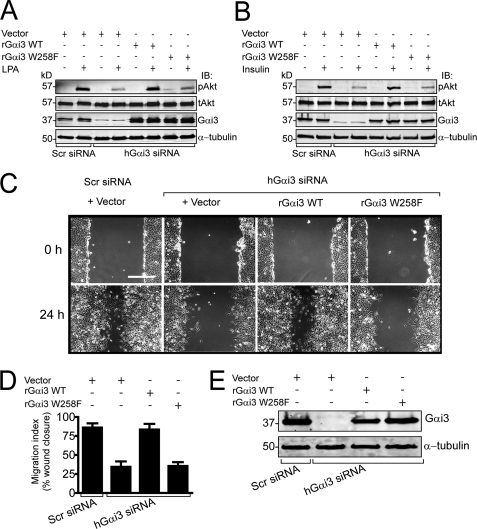FIGURE 9.
Gαi3 W258F fails to rescue Akt activation and cell migration defects observed upon depletion of endogenous Gαi3. A and B, HeLa cells treated with scrambled (Scr) or hGαi3 siRNA oligonucleotides and the indicated DNA plasmids (empty vector, rGαi3 WT, or rGαi3 W258F) were serum-starved for 6 h and stimulated with 10 μm LPA (A) or 100 nm insulin (B) for 5 min. Cell lysates were analyzed by immunoblotting (IB) for total (tAkt) and S473 phospho-Akt (pAkt), Gαi3, and α-tubulin. Depletion of endogenous Gαi3 reduces LPA-stimulated (A) and insulin-stimulated (B) Akt activation by ∼70%, which is restored upon transfection of wt rGαi3 but not rGαi3 W258F. C, in controls (Scr siRNA), HeLa cells cover the majority of the experimental wound area after 24 h, whereas in Gαi3-depleted cells wound closure is greatly impaired. The ability to migrate and close the wound area at 24 h is restored by transfection of rGαi3 wt but not rGαi3 W258F. HeLa cell monolayers treated with the indicated siRNA oligonucleotides, and DNA plasmids were scratch-wounded and examined by light microscopy immediately (0 h) or 24 h after wounding. Scale bar = 500 μm. D, bar graph showing quantification of the wound area covered by cells in C. The area covered by cells was determined by calculating the difference between the wound area at 0 and 24 h expressed as percent of the wound area at 0 h. Results are shown as mean ± S.D. of 8–12 randomly chosen fields from three independent experiments. E, cell lysates from cells treated as in C were immunoblotted to assess the efficiency of siRNA depletion of Gαi3 (∼95%) and the expression of rGαi3 WT or rGαi3 W258F.

